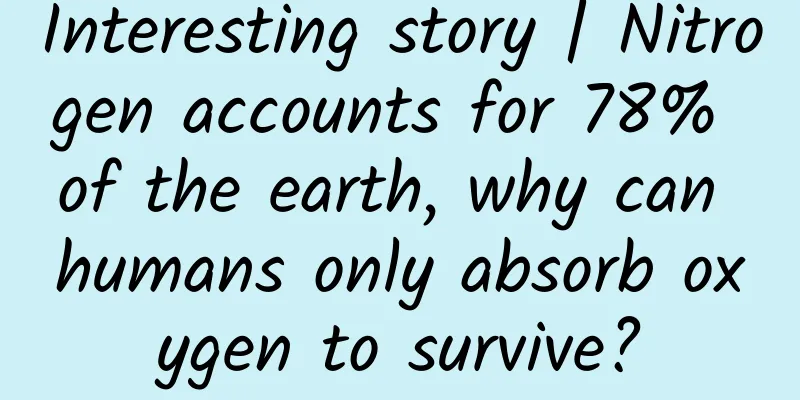Interesting story | Nitrogen accounts for 78% of the earth, why can humans only absorb oxygen to survive?

|
The atmosphere is 78% nitrogen and only 21% oxygen. So why did animals evolve to breathe oxygen when there was more nitrogen needed? Some trees fix nitrogen through their roots, but are there any animals that rely on nitrogen? We all (humans, animals and plants) depend on nitrogen, as every protein contains nitrogen as one of its building blocks. Humans get nitrogen from plant and/or animal sources to make proteins. Even plants (and bacteria) that can fix nitrogen cannot use nitrogen directly from the air to build proteins, but instead get it in the form of ammonia or as nitrates. Why oxygen? Oxygen can react with carbohydrates in an exothermic reaction, thus providing energy. Nitrogen has no similar reaction as an ingredient. Nitrogen is a fairly inert chemical (it does react, but not as much as oxygen - which is why it is fairly stable in the atmosphere, while oxygen has to be constantly regenerated through photosynthesis). Even more interesting is whether life could have formed using chlorine as an oxidant? A very different kind of photosynthesis would be required to generate chlorine from sodium chloride or other chlorides; but if such photosynthesis existed, it does not seem implausible that some life forms could have evolved to extract energy by reversing the photosynthetic process using free chlorine, just as animals today reverse the oxygenic photosynthetic process of plants. There are microorganisms that can utilize nitrogen gas (they are responsible for the nitrogen fixing ability of plants like beans.) But as mentioned above, (the chemical formula for nitrogen) N2 gas is less reactive. It takes more energy to break the N-N bond. Living things obtain energy from chemical reactions involving the transfer of electrons, called redox reactions. Various substances can be used as electron donors, and various substances can be used as electron acceptors. In animals, O2 is an electron acceptor. Some organisms can use nitrate (NO3), nitrite (NO2), sulfate (SO4), carbon dioxide, and ferric iron as electron acceptors. Why we evolved to use oxygen, I'm not sure, but I'd guess it would have something to do with the relative abundance of things like O2, glucose, and water, and the energy expenditure at the end, since not all redox reactions produce the same amount of energy. Here's a fun little fact. Per weight, a chocolate chip cookie contains more energy than TNT. This doesn't seem right, because I can't blow up a car with a chocolate chip cookie, even if I light it with a lighter. The difference between the two has to do with the rate at which the energy is released. And I suspect that some chemical reactions may release energy too quickly or too slowly for some organisms. The real secret is that oxygen is the main source of chemical energy that air-breathing organisms want to use. A physical chemist's perspective (I have little knowledge and no expertise in physiology or medicine): Oxygen is a very high energy chemical. Nitrogen is a very low energy chemical. The oxygen currently present in the Earth's atmosphere is a biogenic gas. It is a surplus from 2 billion years of photosynthesis: sunlight energy + water + carbon dioxide (or ocean bicarbonate ions) -> carbohydrates + oxygen + chemical energy. The chemical energy is distributed between carbohydrates and oxygen. Most of it must be associated with oxygen, because you can get the most energy from anaerobic (without oxygen) degradation of carbohydrates Carbohydrate -> Graphite + Water When oxygen is available, only about 15% of the energy is available Carbohydrates + oxygen -> carbon dioxide + water. Not only is nitrogen unreactive, it also lacks chemical energy. Therefore, the only energy available to any reaction involving nitrogen is the chemical energy from the other reactants. All living things need nitrogen in other forms as a basis for proteins, which are central to their function. But the "low chemical energy" reason is that nitrogen-fixing organisms usually (if not always) exist in symbiotic arrangements with other organisms: "I will provide my nitrogen needs from atmospheric nitrogen chemistry, as well as my own continued existence and replication, if you can provide my energy needs." (Statement: This article is from Cosmic Decoding. It is reproduced for learning and communication only, not for commercial purposes. All reproduced articles will indicate the source. If the original author of the article or photo has any objection, please contact us in the background and we will quickly process or delete it. Thank you for your support.) |
<<: Papaya seeds never thought that they would one day become a substitute for caviar
>>: 2,500 times a year, how many people are risking their lives to "go to the toilet"? !
Recommend
Content: Social media promotion and communication routines
The verbs most commonly associated with traffic a...
Ye Maozhong's "Conflict Marketing Theory" (19 lessons) audio
Audio resource introduction of Ye Maozhong's ...
APP promotion: How to quickly be seen by more users after the product is launched!
Developing an APP is actually not difficult. The ...
Tesla's logic and troubles in moving eastward: There are still three major problems to be solved in building a factory
The rumor was eventually debunked in the clarific...
What work scenarios will the new Google Glass be aimed at?
Beijing time, July 31, search giant Google is try...
What wearables are worth looking forward to at MWC 2015?
The 2015 Mobile World Congress (MWC 2015) will ki...
【Creative Cultivation Program】Why do you feel hot when the temperature is 30 degrees, but feel cold when taking a shower with 30-degree water?
Author: Wang Pingguo Reviewer: Ma Zansong, Deputy...
How does Kuaishou attract traffic? Detailed explanation of Kuaishou traffic diversion!
How to attract traffic through Kuaishou ? I think...
14 top development communities frequented by foreign programmers
[[146603]] Let's take a look at the 14 top de...
To improve advertising conversion, these data analyses should be done well!
Mobile advertising is very popular among enterpri...
General Motors announces new product plan: 20 electric vehicles in 5 years
General Motors announced yesterday that it will l...
The Moon is "Rusting", and the Reason is the Earth?
On March 15, the National Space Administration an...
Caixuetang's "Stock Market Trend Trading Method 1+2+3" deciphers the main trading techniques and gives you the supreme strategy system
Caixuetang's "Stock Market Trend Trading...
Tips and strategies for doing fission activities!
This article is mainly divided into 5 parts: Firs...
How to operate mutual financial products: 4 major user behavior funnels and conversion strategies
For user operations , it is necessary to analyze ...









